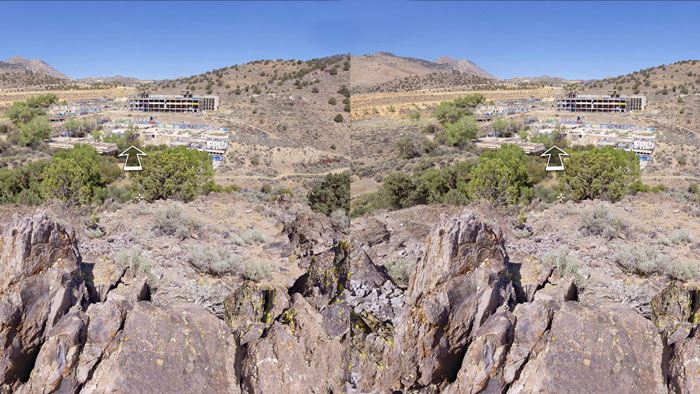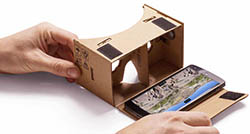23 Mar Explore American Flat Mill through a Head-Mounted Display

With your smartphone and Google Cardboard you can enter the buildings of the now-vanished American Flat Mill. Click to see the transformation.
With BLM support, we photographed in 2014 a 137-node tour of the American Flat Mill complex. Completed in February of 2015, this virtual tour, along with many historical images, may be found at the original American Flat Mill page.
The current page, however, is designed to extend the verisimilitude. We can now present the virtual tour of the American Flat Mill using a head-mounted display (HMD). While HMD technology is still in its infancy, the acquisition of the Kickstarted Oculus Rift by Facebook in 2014 brought the attention of technologists, stock analysts, and the general public to this new frontier of mediated experience. There are now hundreds of virtual tours, 360° videos, games, and simulations available for those with the required hardware, which, for the Oculus, mandates a muscular processor and display driver.
The conventional virtual tour, as deployed throughout All Around Nevada, presents the user-navigable VR tours of the different sites on the screen of a computer or tablet. The user sees this as a narrow segment of his visual environment, and must stare at the screen and interact with it by using a mouse to drive a cursor. On a tablet navigation is accomplished by dragging a finger across the display.
The head-mounted display on the other hand, completely dominates the visual field of the user. It therefore isolates her from the distractions of the actual physical environment and encompasses the entire field of view, including the peripheral space, with the mediated visual experience. Navigation is immediate and intuitive; move your head and/or rotate your body to explore the 360° virtual space. Align the crosshairs target with the arrow to advance to the next scene.
The HMD American Flat Mill tour was developed and tested with the Oculus Rift. This is a rather expensive ($600) solution. If you should happen to own an Oculus Rift, you will be able to access the HMD American Flat Mill tour here, on a PC, using a special webVR-enabled browser such as Firefox Nightly or Google Chromium.
There are other HMD hardware solutions that are or will soon be available, but these have not been tested with the American Flat Mill HMD tour.
In a move calculated to bring the HMD VR experience to the masses, Google introduced in 2104 a simple fold-along-the-dotted-line solution, called Google Cardboard. This is not a complete HMD, with its own twin LCD screens. With Google Cardboard, your own smartphone becomes the display screen. See the FAQ below for a list of compatible smartphones. You can download from Google a hardware list and a template that will enable you to assemble your own device from easily obtainable materials. Or you can purchase, as we did, a packaged kit with everything included, for around $15.
Once you have assembled your Google Cardboard, before inserting your smartphone, touch the image below to enter the HMD version of the American Flat Mill virtual tour. Then touch the “Enter VR” button. Then you can place your smartphone into your Google Cardboard and explore just a few of the VR nodes of the American Flat Mill tour. To navigate within the scene, turn your head to align the crosshairs target with the arrow.

If you have your head-mounted display, touch the image to load the special American Flat Mill tour. Then touch the HMD-like icon in the toolbar. To navigate, turn your head to align the crosshairs target with the arrow.
FAQ
1. Which smartphones are compatible with Google Cardboard?
2. I see two images, they are not blending together.
4. After I touch “Enter VR,” the two images on my phone are vertical, even when I rotate the phone.








No Comments